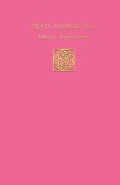Abstract
The complexities of the historical gyres or cones in A Vision constitute problems with which most scholars or students of Yeats have wrestled, often in vain. In many instances, Yeats and his “instructors” have compounded the confusion through their manner of presenting the materials. A major case in point is the large double cone with dates and “phases” placed at the beginning of “Dove or Swan” in both versions of the book (1925 and 1937, hereafter referred to as VA and VB respectively).
Access this chapter
Tax calculation will be finalised at checkout
Purchases are for personal use only
Preview
Unable to display preview. Download preview PDF.
Notes
A. Norman Jeffares states, “In Yeats’s mind the era of Christianity began with the point of the cone, and the gyre then begun had almost reached its fullest expansion [in the twentieth century]” (W. B. Yeats: Man and Poet, 2nd edn [London: Routledge and Kegan Paul, 1962], pp. 203–4).
Similarly, Richard Ellmann says, “This poem [“The Second Coming”] could not have been written with such prophetic authority without the Vision, and the ‘widening gyre’ is obviously the gyre of objectivity [primary tincture] there discussed” (Yeats: The Man and the Masks [New York: Macmillan, 1948], p. 233).
See also Morton Irving Seiden, William Butler Yeats: The Poet as a Mythmaker, 1865–1939 (East Lansing: Michigan State University Press, 1962) p. 234.
Robert O’Driscoll, “ ‘The Second Coming’ and Yeats’s Vision of History” in A Festschrift for Edgar Ronald Seary: Essays in English Language and Literature Presented by Colleagues and Former Students (St. Johns: Memorial University of Newfoundland, 1975) pp. 173 and 176.
The 1962 and 1969 reprintings of the 1962 London edition preserved the use of two colours, but the 1974 reprinting inaugurated the use of black ink for both parts of the diagram, a practice continued in subsequent re-issues of this edition. Finneran’s articles are “A Preliminary Note on the Text of A Vision (1937)” in Yeats and the Occult, ed. George Mills Harper (Toronto: Macmillan of Canada, 1975), pp. 317–20, and “On Editing Yeats: the Text of A Vision (1937)”, Texas Studies in Literature and Language, 19 (1977) pp. 119–34. The latter article supersedes the former.
Editor information
Editors and Affiliations
Copyright information
© 1985 Warwick Gould
About this chapter
Cite this chapter
Allen, J.L. (1985). “The Red and the Black”: Understanding “The Historical Cones”. In: Gould, W. (eds) Yeats Annual No. 3. Yeats Annual. Palgrave Macmillan, London. https://doi.org/10.1007/978-1-349-06206-5_19
Download citation
DOI: https://doi.org/10.1007/978-1-349-06206-5_19
Publisher Name: Palgrave Macmillan, London
Print ISBN: 978-1-349-06208-9
Online ISBN: 978-1-349-06206-5
eBook Packages: Palgrave Literature & Performing Arts CollectionLiterature, Cultural and Media Studies (R0)

